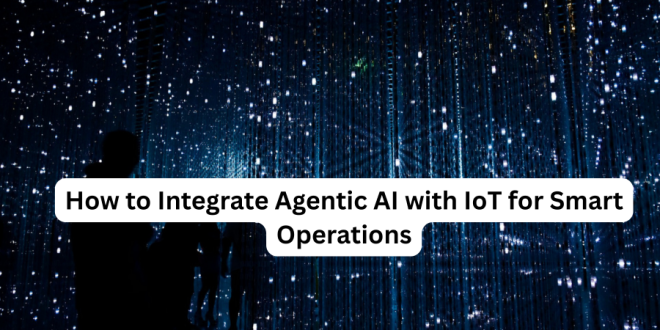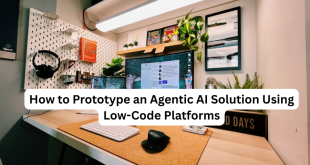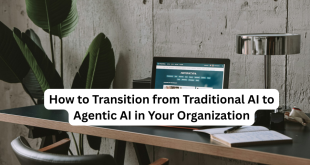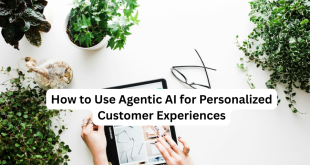The Internet of Things (IoT) and Agentic AI are a match made in tech heaven. IoT devices generate real-time data from connected systems—like smart thermostats, factory sensors, or delivery trackers—while Agentic AI autonomously analyzes and acts on that data to optimize operations. For businesses, this duo unlocks smarter workflows, from predictive maintenance in manufacturing to energy-efficient smart homes. In this guide, we’ll show you how to integrate Agentic AI with IoT to create intelligent, scalable operations, even if you’re starting with limited resources.
Why Combine Agentic AI and IoT?
Agentic AI goes beyond traditional AI by making independent decisions to achieve goals, such as rerouting a delivery truck or adjusting a factory’s production schedule. When paired with IoT’s real-time data streams, it enables:
- Proactive Decision-Making: Anticipate issues, like equipment failures, before they happen.
- Cost Savings: Optimize energy use or supply chains, with IoT markets projected to hit $1.6 trillion by 2025.
- Enhanced Experiences: Deliver personalized services, like smart retail shelves that restock based on customer demand.
Whether you run a small business, manage a warehouse, or develop smart city solutions, integrating these technologies can transform your operations. Here’s how to do it, step by step.
Step 1: Identify Your IoT Use Case
Start by pinpointing where IoT and Agentic AI can add value. Common applications include:
- Smart Manufacturing: Sensors monitor machines, and AI schedules maintenance to prevent downtime.
- Logistics: IoT trackers monitor shipments, while AI optimizes routes in real time.
- Smart Homes/Cities: Devices like smart meters send usage data, and AI adjusts settings for efficiency.
- Retail: IoT shelves track inventory, and AI orders stock autonomously.
Action Item: Choose one specific process to enhance. For example, “Reduce factory downtime by predicting equipment failures.” Define the IoT devices (e.g., temperature sensors) and AI actions (e.g., scheduling repairs) needed.
Step 2: Select IoT Devices and Platforms
IoT devices collect data, but they need to integrate seamlessly with your AI system. Start with affordable, scalable hardware and platforms:
- IoT Devices:
- Raspberry Pi: A low-cost option for prototyping sensors or smart devices, starting at $35.
- Arduino: Ideal for custom IoT projects, like environmental monitoring.
- Commercial Sensors: Companies like Siemens or Bosch offer plug-and-play sensors for industrial use.
- IoT Platforms:
- AWS IoT Core: Connects devices to the cloud, with tools for data processing and AI integration.
- Google Cloud IoT: Simplifies device management and pairs with Google’s AI services.
- Microsoft Azure IoT Hub: Supports secure device connections and integrates with Azure AI.
Action Item: Pick devices that match your use case (e.g., vibration sensors for manufacturing) and a platform with free tiers, like AWS IoT Core, for testing. Ensure devices support standard protocols like MQTT or HTTP for easy data transfer.
Step 3: Choose an Agentic AI Framework
Your AI needs to process IoT data and act autonomously. Select tools that support decision-making and integration with IoT platforms:
- Cloud-Based AI:
- Google Cloud AI: Offers pre-built models for predictive analytics, ideal for processing IoT sensor data.
- Azure Cognitive Services: Provides decision-making APIs for tasks like anomaly detection.
- Open-Source Frameworks:
- Rasa: Builds conversational agents that can act on IoT data, like responding to alerts.
- TensorFlow: Customizable for creating AI models that analyze IoT streams.
- Low-Code Options:
- Microsoft Power Automate: Creates automated workflows triggered by IoT data, no coding required.
Example: A logistics company might use AWS IoT Core to collect GPS data from trucks and TensorFlow to build an AI that reroutes vehicles based on traffic.
Action Item: Choose a framework based on your expertise. Non-coders can start with Power Automate; developers might prefer TensorFlow or Rasa. Check if your IoT platform (e.g., AWS) integrates natively with your AI tool.
Step 4: Collect and Prepare IoT Data
Agentic AI thrives on quality data. IoT devices generate streams of information, but you need to structure it for AI processing.
- Data Types: Collect relevant metrics, like temperature, humidity, or location, depending on your use case.
- Data Cleaning: Filter out noise (e.g., erroneous sensor readings) using tools like Python or platform dashboards.
- Storage: Store data in a cloud database (e.g., AWS DynamoDB or Google BigQuery) for real-time access.
Pro Tip: Start with a small dataset to test your system. For example, collect one week of sensor data from a single machine.
Action Item: Set up your IoT devices to send data to your chosen platform. Use built-in tools (e.g., Azure IoT Hub’s data routing) to clean and store it. Expect 1–2 weeks for setup and testing.
Step 5: Build and Train Your Agentic AI
Now, create an AI agent that acts on IoT data. Follow these steps:
- Define Actions: Specify what your AI should do, like sending alerts or adjusting settings. For instance, “If a machine’s temperature exceeds 80°C, schedule maintenance.”
- Train the Model: Use IoT data to train your AI. For example, feed historical sensor data into a TensorFlow model to predict failures.
- Set Rules: For simple agents, use rule-based logic in platforms like Power Automate (e.g., “If stock falls below 10 units, order more”).
- Test Autonomy: Simulate scenarios to ensure the AI makes correct decisions without human input.
Example: A smart building used Azure IoT Hub to collect energy usage data and Azure AI to adjust HVAC settings autonomously, cutting energy costs by 20%.
Action Item: Build a prototype agent using your chosen framework. Test it with sample IoT data to verify decisions, refining the model as needed.
Step 6: Integrate and Deploy
Connect your IoT and AI systems for seamless operation:
- APIs and Protocols: Use APIs to link IoT platforms (e.g., AWS IoT Core) with AI services (e.g., Google Cloud AI). Most platforms support REST or MQTT.
- Real-Time Processing: Ensure your AI processes IoT data in real time, using stream-processing tools like AWS Kinesis or Azure Stream Analytics.
- Deployment: Launch your system in a controlled environment, like a single factory line or a small fleet of vehicles.
Action Item: Follow your platform’s integration guide (e.g., AWS IoT’s documentation) to connect devices and AI. Test the full system for 1–2 weeks to catch bugs.
Step 7: Monitor and Scale
Once deployed, monitor performance and plan for growth:
- Track KPIs: Measure outcomes like downtime reduction, cost savings, or response time. For example, “Did predictive maintenance cut repair costs by 15%?”
- Gather Feedback: Check if the system meets user needs, like employees in a factory or customers in a smart home.
- Scale Up: Add more devices (e.g., sensors across multiple sites) or enhance AI capabilities (e.g., adding predictive analytics).
Pro Tip: Use platform dashboards (e.g., Google Cloud’s IoT monitoring) to visualize performance and spot issues.
Action Item: Set a monthly review to analyze KPIs and update the system. Plan to scale by adding devices or features, like integrating with a CRM for retail insights.
Step 8: Address Security and Ethics
IoT and AI systems handle sensitive data, so prioritize security and responsibility:
- Secure Data: Encrypt IoT data streams and use secure protocols (e.g., TLS). Platforms like Azure IoT Hub offer built-in encryption.
- Access Control: Limit who can modify AI or IoT settings, using role-based access in your platform.
- Ethical AI: Ensure AI decisions are transparent and fair. For example, disclose when customers interact with an AI-driven system.
Action Item: Review your platform’s security features and enable encryption and access controls. Schedule quarterly audits to check for vulnerabilities or biases.
Getting Started Today
Integrating Agentic AI with IoT can revolutionize your operations, making them smarter and more efficient. Here’s a quick recap:
- Identify a specific IoT-AI use case.
- Select affordable IoT devices and platforms like AWS IoT Core.
- Choose an AI framework, such as TensorFlow or Power Automate.
- Collect and clean IoT data.
- Build and train your AI agent.
- Integrate and deploy the system.
- Monitor performance and scale as needed.
- Prioritize security and ethics.
Ready to dive in? Start small with a Raspberry Pi sensor and a free AWS IoT Core trial to prototype your solution. Test a single use case, like monitoring a store’s inventory, and scale from there. With Agentic AI and IoT, you’re not just automating—you’re building the future of smart operations.
 UBUCH ubuch | Honest Tech Reviews & Tutorials for Everyone
UBUCH ubuch | Honest Tech Reviews & Tutorials for Everyone




